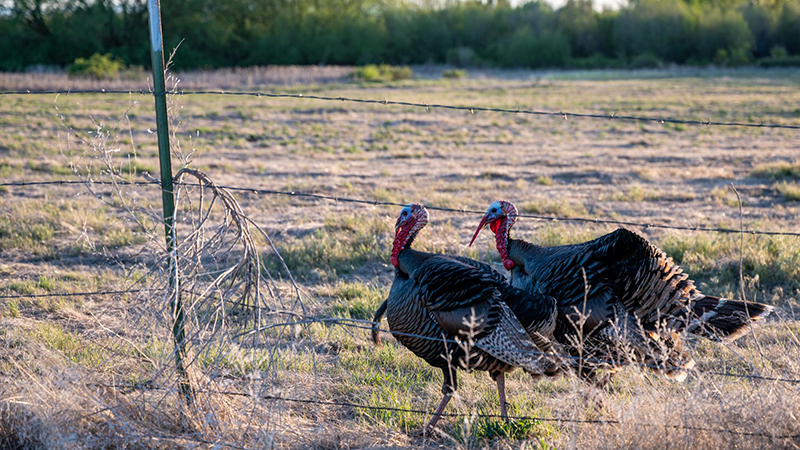
Wild Turkey Ecology in Western Nebraska
Collaborator(s): Andrew (Andy) Little, Sarah Sonsthagen, Mark Vrtiska
Wild turkeys are an economically important game species in Nebraska. In recent years, land managers and hunters across Nebraska have reported declines in the number of wild turkey, similar to other states across the USA. Precise explanations are typically lacking, but most populations across the USA appear to have reported declines in productivity (e.g., nest success, brood survival). To reverse this decline, other state wildlife agencies have reduced wild turkey bag limits and prioritized habitat management efforts to increase recruitment and adult female survival in the breeding season. These efforts have slowed wild turkey population declines across the country, but populations continue to decline in certain areas, suggesting there are other site-specific factors affecting population growth rates (e.g., landcover availability, brood and hen survival, etc.).
One potential driver of this decline may be the influence of increasingly fragmented land cover patches due to increases in agricultural crop production, infrastructure development (e.g., roads, cities, urban sprawl), and energy development. For example, Hubert (2004) found female wild turkeys selected for upland forest, riparian forest and rural grassland and avoided row crop fields throughout the year in intensively farmed landscapes in Illinois. This suggests that forested and grassland cover types are significantly important to wild turkeys in intensive agricultural landscapes and increasing fragmentation of these patches may negatively affect wild turkey populations. Furthermore, intensive agricultural landscapes may influence the availability of suitable nesting cover for wild turkeys. In southern Illinois, Delahunt (2011) found successful nests were closer to forest cover and roads, whereas unsuccessful nests were closer to agricultural fields.
Another potential driver of wild turkey population declines is overharvest of male wild turkeys and the potential impact on wild turkey population dynamics. Recent research has illustrated that harvest and removal of active, male wild turkeys also may affect reproductive rates of females (Chamberlain et al. 2018, Isabelle et al. 2018). The disruption of male sibling groups may degrade dominance hierarchies, which in turn, could affect parentage of clutches and genetics (Krakauer 2008).
Lastly, an important consideration for spring turkey season is gobbling chronology as it directly influences turkey hunter satisfaction. Historically, spring turkey hunting seasons are based on perceived relationships between gobbling activity and nesting phenology with the primary goal of targeting the season structure around peak gobbling activity. Therefore, research is needed to understand how factors such as environmental variation and hunting pressure influence gobbling activity, and how gobbling activity correlates with nesting phenology across Nebraska. This information will help wildlife managers make informed management decisions regarding the timing of spring hunting season.
Expected Results and Benefits:
- Obtain reproductive estimates (e.g., nesting and brood-rearing success, heterozygosity fitness correlation) and harvest information to assist NGPC with the future development of a wild turkey integrated population model.
- Development of integrated movement (telemetry and genetic data) and habitat suitability models across regions of Nebraska to help identify and prioritize areas for conservation delivery.
- Understand the role of paternal/maternal genetics on wild turkey population success and guide harvest recommendations.
- Gobbling chronology will aid biologists in evaluating the timing of spring wild turkey season relative to reproductive chronology and harvest susceptibility.
- Improve public engagement and education on wild turkey management in Nebraska through the expansion of the Upland Game Bird Science Literacy website with the inclusion of information on wild turkeys.